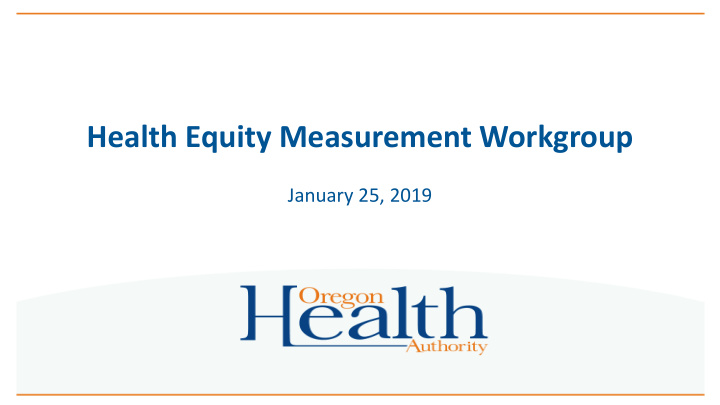



Health Equity Measurement Workgroup January 25, 2019
Today’s Agenda ✓ Welcome o Approve previous meeting minutes ✓ Review draft workplan ✓ Public Testimony ✓ Review potential data and measure sets for considerations o Decision point: Next steps for February ✓ Adjourn 2
Draft Workplan: 2019 Health Equity Measurement Workgroup Goals/Objectives: • Develop short and long-term recommendations to the Oregon Health Policy Board and associate measurement and health equity committees regarding the measurement of health equity in Oregon healthcare. Strategies: • Identify specific measures for both short and long-term consideration • Identify specific data collection guidance to improve demographic data collection for short and long-term • Align with Social Determinants of Health (SDOH) measure data efforts 3
Draft Workplan – continued: Milestones (key deliverables/actions with specific target dates): • February 5, 2019- short term recommendations to OHPB • February 14, 2019 – short term recommendations to Health Plan Quality Metrics Committee (HPQMC) for 2020 • May 2019 – progress report and feedback session with other committees • October 2019 – long-term recommendations to OHPB • January 2020- measure proposal to HPQMC for 2021 measure set and beyond. 4
Public comment (2:10) 5
Data and measure sets for considerations Three items for consideration 1. Ambulatory Sensitive Care Measures (PQI) by CCO and Race/ Ethnicity – data measurement 2. TQS (transformation and quality strategy) projects by CCO and member population – attestation 3. Primary Care Access – data measurement Supporting information • Data Sharing Overview (high-level overview of the process to share data between OHA and external partners 6
Ambulatory Sensitive Care Measures (PQI) by CCO and R/E ✓ Attachment 2: PQIs by CCO and RE (Race/Ethnicity) ✓ Attachment 3: PQI pages from 2017 CCO Metrics Report • There are 4 PQI measures presented today. • PQIs, or Prevention Quality Indicators, are a set of indicators to track avoidable hospitalizations. • Rates are shown per 100,000 member years which means that in one year, there are on average X visits occurring per 100,000 CCO member years. • When divided by race/ethnicity, these measures can be very sensitive to change. This means that an increase of 1-2 members could result in big jumps in the rate, especially for smaller CCOs. 7
Ambulatory Sensitive Care Measures (PQI) by CCO and R/E PQI 1: Diabetes short-term complications admission rate - Rate of adult members (ages 18 and older) with diabetes who had a hospital stay because of a short-term problem with from their disease. A lower score is better. PQI 5: COPD or asthma in younger adults admission rate - Lorem Rate of adult members (ages 40 and older) who had hospital stay because of chronic obstructive pulmonary disease or asthma. A lower score is better. PQI 8: Congestive heart failure admission rate - Rate of adult members (ages 18 and older) who had a hospital stay because of congestive heart failure. A lower score is better PQI 15: Asthma in younger adults admission rate - Rate of adult members (ages 18-39) who had a hospital stay because of asthma. A lower score is better. 8
TQS projects by CCO and member population • Background and rationale • What is TQS? • Proposal concepts and community engagement process • Proposal domains – Description – Community Feedback – Goals – Measurements 9
Primary Care Access by Race/Ethnicity (1/2) Measure Definition: Percentage of patients who have at least one qualifying visit with a Primary Care Provider (PCP) during the measurement year, by race/ethnicity categories. The CCO’s baseline average percentage of patients who have at least one qualifying visit with a Primary Care Provider will represent their target in the measurement period. The CCO target will need to be met or exceeded for all race/ethnicity categories in order for the CCO to pass the measure. 10
Equity Measure: Primary Care Access by Race/Ethnicity (2/2) Measure Formula : Numerator : Patients with at least one outpatient visit with a Primary Care Provider during the measurement period. Denominator : All patients who meet the continuous enrollment criteria. Exclusions: Patients with a Race/Ethnicity of ‘Unknown’ or ‘Blank’ will be excluded from the denominator. Race/Ethnicity Categories: * African American/Black * Hispanic/ Latino * Asian American * American Indian/ Alaskan Native * American Indian/ Alaskan Native * Hawaiian/ Pacific Islander * White * Other Race 11
Decision Point: Next steps for February 12
Next Meeting: February 25, 2019 11:00am – 1:00pm Th Thank k yo you a and Adjo journed ed 13
Recommend
More recommend